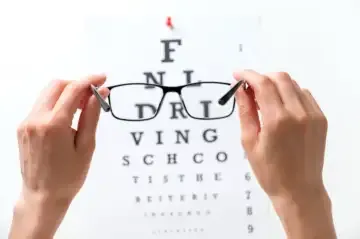Myopia or short-sightedness is an eye condition where a person cannot see objects far away clearly. This vision can be corrected with glasses or contact lenses.
In their latest study, published in the British Journal of Ophthalmology, researchers from China's Sun Yat-Sen University and Henan Provincial People's Hospital, found that around one in three children and teenagers worldwide are short-sighted.
Prompting calls to discourage screen time and increase physical activity, they stated that the Covid lockdowns had a negative impact on eyesight in children, who spent .
"Based on our trend analysis, it has been observed that there has been a significant rise in the occurrence of myopia among children and adolescents globally over the past 30 years, with the prevalence increasing from 24.32% to 35.81%. This increase has been particularly notable after the onset of the Covid-19 pandemic," the researchers wrote.

Myopia or short-sightedness is an eye condition where a person cannot see objects far away clearly. (Photo: Getty Images)The study looked at research involving more than five million children and teenagers from 50 countries across all six continents. The highest rates are in Asia - 85% of children in Japan and 73% in South Korea are short-sighted with more than 40% affected in China and Russia.
Their analysis showed that the prevalence of short-sightedness has tripled from 1990 to 2023, reaching 36%. The study warns that myopia is an escalating global health issue, projected to exceed 740âmillion cases by 2050.
Myopia usually begins in school, which tends to worsen over time, until the eye has stopped growing, till 20 years of age.

The highest rates are in Asia - 85% of children in Japan and 73% in South Korea are short-sighted with more than 40% affected in China and Russia. (Photo: Getty Images)Several factors increase the likelihood of , with living in East Asia being one of the most significant. Genetics, or the traits passed down from parents, play a role, but other influences exist as well.
In regions like Singapore and Hong Kong, children begin formal education as early as two years old. This early exposure to reading and screen time puts extra strain on their eyes, which research suggests can lead to myopia.
In contrast, myopia is seven times less common in Africa, where children typically start school at the age of six to eight years old.
The study further indicates that than boys, partly due to spending less time outdoors both at school and home as they grow up.
Additionally, girls often enter puberty earlier, which may lead to the onset of short-sightedness at a younger age.

Girls often enter puberty earlier, which may lead to the onset of short-sightedness at a younger age. (Photo: Getty Images)"With the increase in enrolment pressure, students are experiencing a rise in learning pressure and burden. As a result, they are spending more time focusing on close-range activities with their eyes, which reduces the time they spend on outdoor sports and exercise.34 This constant strain on the ciliary muscles often leads to eye fatigue and myopia," the researchers wrote.
While Asia is projected to have the , with nearly 69% of the population affected, developing countries could also see rates as high as 40%, according to researchers.
The researchers added, "According to our projections, there is an anticipated 9% rise in the overall prevalence of myopia between 2023 and 2050, which will lead to a substantial burden of ocular disease, affecting more than 740 million children and adolescents."
The common signs and symptoms of myopia or short-sightedness include difficulty reading words from a distance, like reading the board at school, sitting close to the television or laptop or holding a tablet or phone too close to the eyes, getting frequent headaches, and rubbing the eyes a lot.

 Myopia or short-sightedness is an eye condition where a person cannot see objects far away clearly. (Photo: Getty Images)The study looked at research involving more than five million children and teenagers from 50 countries across all six continents. The highest rates are in Asia - 85% of children in Japan and 73% in South Korea are short-sighted with more than 40% affected in China and Russia.
Their analysis showed that the prevalence of short-sightedness has tripled from 1990 to 2023, reaching 36%. The study warns that myopia is an escalating global health issue, projected to exceed 740âmillion cases by 2050.
Myopia usually begins in school, which tends to worsen over time, until the eye has stopped growing, till 20 years of age.
Myopia or short-sightedness is an eye condition where a person cannot see objects far away clearly. (Photo: Getty Images)The study looked at research involving more than five million children and teenagers from 50 countries across all six continents. The highest rates are in Asia - 85% of children in Japan and 73% in South Korea are short-sighted with more than 40% affected in China and Russia.
Their analysis showed that the prevalence of short-sightedness has tripled from 1990 to 2023, reaching 36%. The study warns that myopia is an escalating global health issue, projected to exceed 740âmillion cases by 2050.
Myopia usually begins in school, which tends to worsen over time, until the eye has stopped growing, till 20 years of age.
 The highest rates are in Asia - 85% of children in Japan and 73% in South Korea are short-sighted with more than 40% affected in China and Russia. (Photo: Getty Images)Several factors increase the likelihood of , with living in East Asia being one of the most significant. Genetics, or the traits passed down from parents, play a role, but other influences exist as well.
In regions like Singapore and Hong Kong, children begin formal education as early as two years old. This early exposure to reading and screen time puts extra strain on their eyes, which research suggests can lead to myopia.
In contrast, myopia is seven times less common in Africa, where children typically start school at the age of six to eight years old.
The study further indicates that than boys, partly due to spending less time outdoors both at school and home as they grow up.
Additionally, girls often enter puberty earlier, which may lead to the onset of short-sightedness at a younger age.
The highest rates are in Asia - 85% of children in Japan and 73% in South Korea are short-sighted with more than 40% affected in China and Russia. (Photo: Getty Images)Several factors increase the likelihood of , with living in East Asia being one of the most significant. Genetics, or the traits passed down from parents, play a role, but other influences exist as well.
In regions like Singapore and Hong Kong, children begin formal education as early as two years old. This early exposure to reading and screen time puts extra strain on their eyes, which research suggests can lead to myopia.
In contrast, myopia is seven times less common in Africa, where children typically start school at the age of six to eight years old.
The study further indicates that than boys, partly due to spending less time outdoors both at school and home as they grow up.
Additionally, girls often enter puberty earlier, which may lead to the onset of short-sightedness at a younger age.
 Girls often enter puberty earlier, which may lead to the onset of short-sightedness at a younger age. (Photo: Getty Images)"With the increase in enrolment pressure, students are experiencing a rise in learning pressure and burden. As a result, they are spending more time focusing on close-range activities with their eyes, which reduces the time they spend on outdoor sports and exercise.34 This constant strain on the ciliary muscles often leads to eye fatigue and myopia," the researchers wrote.
While Asia is projected to have the , with nearly 69% of the population affected, developing countries could also see rates as high as 40%, according to researchers.
The researchers added, "According to our projections, there is an anticipated 9% rise in the overall prevalence of myopia between 2023 and 2050, which will lead to a substantial burden of ocular disease, affecting more than 740 million children and adolescents."
The common signs and symptoms of myopia or short-sightedness include difficulty reading words from a distance, like reading the board at school, sitting close to the television or laptop or holding a tablet or phone too close to the eyes, getting frequent headaches, and rubbing the eyes a lot.
Girls often enter puberty earlier, which may lead to the onset of short-sightedness at a younger age. (Photo: Getty Images)"With the increase in enrolment pressure, students are experiencing a rise in learning pressure and burden. As a result, they are spending more time focusing on close-range activities with their eyes, which reduces the time they spend on outdoor sports and exercise.34 This constant strain on the ciliary muscles often leads to eye fatigue and myopia," the researchers wrote.
While Asia is projected to have the , with nearly 69% of the population affected, developing countries could also see rates as high as 40%, according to researchers.
The researchers added, "According to our projections, there is an anticipated 9% rise in the overall prevalence of myopia between 2023 and 2050, which will lead to a substantial burden of ocular disease, affecting more than 740 million children and adolescents."
The common signs and symptoms of myopia or short-sightedness include difficulty reading words from a distance, like reading the board at school, sitting close to the television or laptop or holding a tablet or phone too close to the eyes, getting frequent headaches, and rubbing the eyes a lot.